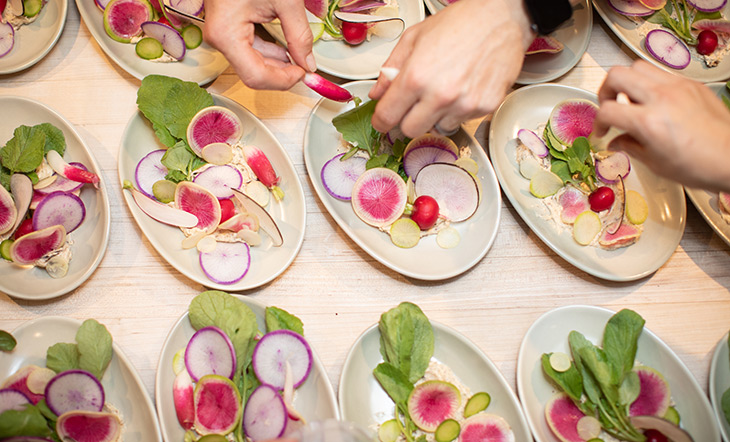Re-Opening With Safety in Mind
The authors of our playbook, "Safety First," weigh in
Maggie BordenMay 29, 2020

This spring, we've been hosting webinars as part of our Industry Support learning series. Topics have covered all facets of the current crisis, from deciphering government relief options, staying motivated in the face of stress, writing your first cookbook, and more. Earlier this month, we gathered together chefs and restaurant owners with the lead authors of our new re-opening playbook, Safety First, created in collaboration with the Aspen Institute, World Central Kitchen, and Off Their Plate. Check out some of the top takeaways from their discussion below, and download a copy of Safety First here.
1. Dr. Sam Dooley, an epidemiologist, explained that there is a hierarchy of infection control:
- Source control: identify the source of infection and eliminate it if you can. Mitigate it if you can’t eliminate. Screen workers for fevers and symptoms, and if they have any symptoms, ask them not to come to work. Wear masks to prevent spread through asymptomatic or pre-symptomatic transmission.
- Environmental/engineering control: keep things clean and disinfected. Have glass/plexiglass barriers when and where you can. Make sure you use ventilation, but don’t recirculate air unless it’s filtered through a HEPA filter.
- Administrative control: enforce rules around masks, washing hands, and physical distancing.
- Personal Protective Equipment (PPE): personal protective equipment includes items—face masks; safety glasses, goggles, or face shields; gloves; and gowns—people wear to protect themselves from becoming infected. Eye protection and gowns are not needed for protection against COVID-19 in commercial kitchens. The efficacy of PPE depends on people knowing what, how, and when to use the equipment. There's the possibility for user error, so you don’t want to rely on PPE alone. Face coverings don't really count as PPE, because most of the surgical/cloth masks people have are designed to prevent spreading COVID-19 to other people, not to prevent catching it yourself. Gloves are not considered PPE for the control of COVID-19 in commercial kitchens, and should not replace handwashing or the need to maintain good hand hygiene.
2. Wear your mask whenever you're around other people, wash it often, and use good hand hygiene. The fit of your mask/face covering is important—your nose, mouth, and chin need to be covered at all times.
3. Give your staff multiple face coverings. Ask them to have separate shoes and clothes that they only wear inside the restaurant to help ensure they're not tracking anything in.
4. Contact tracing is important. Have everyone on your team sign in and sign out, even on breaks, so you know who has been working and at what time. If someone on your team is infected, this log will allow you to identify anyone who might be exposed.
5. If your dining room isn't open, your whole space is now available. Be creative about your business's space when thinking about safety and physical distancing.
Check out what's on-deck for our webinar series.
Our team would like to know what topics you would like us to cover. Please email us at impact@jamesbeard.org with your suggestions on speakers, resources, and issues you would like us to host.






